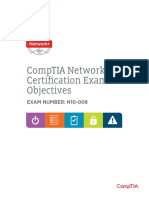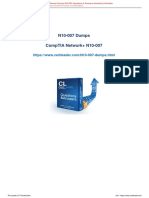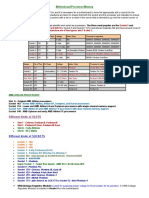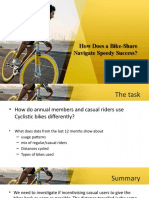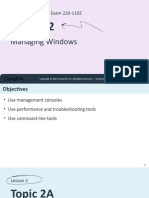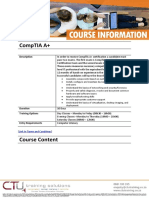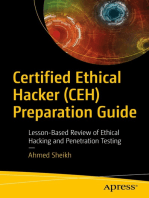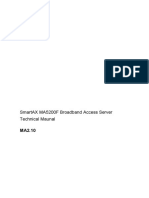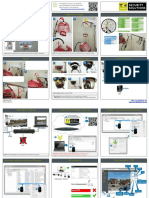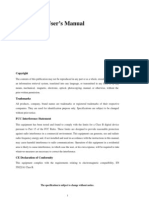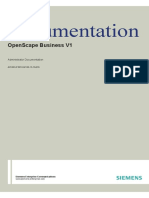CompTIA Network+ Practice Test
CompTIA Network+ Practice Test
Uploaded by
GFFghi89kgrgKHKhjkdkCopyright:
Available Formats
CompTIA Network+ Practice Test
CompTIA Network+ Practice Test
Uploaded by
GFFghi89kgrgKHKhjkdkCopyright
Available Formats
Share this document
Did you find this document useful?
Is this content inappropriate?
Copyright:
Available Formats
CompTIA Network+ Practice Test
CompTIA Network+ Practice Test
Uploaded by
GFFghi89kgrgKHKhjkdkCopyright:
Available Formats
Network+ 100 Question Practice Exam
Developed for www.GetCertify4Less.Com
(Author to remain anonymous.)
This practice exam has been developed exclusively for GetCertify4Less.Com. Answers and explanations on last pages 1. W hat is the length of an IPv4 address? A. 8-bit B. 32-bit C. 128-bit D. 256-bit 2. W hich of the following is the most commonly implemented network topology? A. Star B. Bus C. Ring D. Mesh 3. W hich of the following standards uses twisted pair cable? A. 10BASE5 B. 100BASE-FX C. 100BASE-T D. 10BASE2 4. What is the minimum category of twisted pair cable required when installing a 100BASE-Tx network? A. Category 3 B. Category 4 C. Category 5 D. Category 6 5. W hich of the following wireless standards can transmit data at up to 54 Mbps? (Select the best two answers.) A. 802.11b B. 802.1X C. 802.11g D. 802.11a 6. W hich of the following Ethernet standards can transmit data at up to (and not exceeding) 100 Mbps? A. 802.3 B. 802.3u C. 802.3z D. 802.3ab 7. W hich command would you use to view your IP settings including DNS server and MAC addresses? A. Ping B. Ipconfig C. Tracert D. Ipconfig /all
8. W hich of the following is the loopback address in IPv6? A. 127.0.0.1 B. ::1 C. FE80::/10 D. 0000::10 9. W hich of the following connectors would an unshielded twisted pair (UTP) cable most likely use? A. RJ11 B. RJ45 C. ST D. BNC 10. Local area networks (LANs) are commonly cabled with UTP cable. W hat is the most commonly used cabling standard when wiring LANs? A. 568B B. USOC C. BOGB D. 568A 11. Your boss asks you to connect an RJ45 plug to a CAT5 cable. Which is the best tool to use? A. TDR B. Patch tester C. Punch down tool D. Crimper 12. W hat are two common types of central connecting devices that might be used in a network with a star topology? (Select the best two answers.) A. Switch B. Network adapter C. Hub D. Router 13. W hich of the following devices will protect an entire network from an attacker? A. Hub B. Switch C. Firewall D. Router 14. W hich device connects two LANs to form a W AN? A. Hub B. Switch C. Firewall D. Router 15. W hat is the maximum approximate range of Class 2 Bluetooth devices? A. 1 meter B. 10 meters C. 100 meters D. 1000 meters
16. From the following, select two types of interference. (Select the best two answers.) A. EMI B. Static electricity C. RFI D. Faraday cage 17. You need to install a SOHO router that seconds as a wireless AP. How many channels are normally available to you within the 2.4 GHz range? A. 10 B. 6 C. 11 D. 2.4 18. After you install a SOHO router, you see that it is automatically configured to hand out IP addresses to computers. W hich of the following network numbers does the SOHO router work within to hand out addresses? A. 10.0.0.0 B. 169.254.0.0 C. 172.16.0.0 D. 192.168.1.0 19. You have been instructed to upgrade a Windows Server 2003 computer to a domain controller. W hich command will enable you to do this? A. Dcdemo B. Dcpromo C. DC Ping D. Dcconfig 20. Your boss asks you to connect his Windows Vista laptop to a W indows domain. W hat setting should you configure prior to joining the domain? A. DNS B. Gateway C. W INS D. ARP 21. W hich of the following additional settings does ipconfig /all allow you to view in comparison to the more basic ipconfig? A. IP address B. MAC address C. Gateway address D. Name of the adapter 22. The Media Access Control (MAC) sublayer is part of which OSI model layer? A. Physical B. Data Link C. Network D. Transport
23. At which layer of the OSI model does a router operate? A. Physical B. Data Link C. Network D. Transport 24. W hich of these items works on the network layer of the OSI model? A. TCP message B. HTTP protocol C. Ethernet frame D. IP packet 25. W hich layer of the OSI model does a gateway reside on? A. Physical B. Application C. Network D. Transport 26. W hat is the total number of hosts that can exist on a Class C network? A. 256 B. 65536 C. 254 D. 16,777,214 27. W hich of the following is an example of a Class B network number? A. 192.168.1.0 B. 10.0.0.0 C. 172.16.0.0 D. 127.0.0.1 28. 65.43.18.1 is an example of a public IP address. W hich class is it a member of? A. Class A B. Class B C. Class C D. Class D 29. You are troubleshooting a computer that cannot access the network or the Internet. You run an ipconfig/all and see that the IP address the computer is using is 169.254.36.189. W hat technology is at work here? A. Public networking B. APIPA C. DHCP D. Local loopback 30. W hich of the following are examples of public IP addresses? (Select the best two answers.) A. 10.1.58.244 B. 68.94.128.1 C. 208.152.36.256 D. 208.152.11.46
31. W hich of the following is a valid example of a private IP address? A. 192.168.1.100 B. 192.168.1.258 C. 172.16.0.0 D. 207.192.168.1 32. TCP connections use ports to connect to other computers. What layer of the OSI model does TCP, and ports, reside on? A. Physical B. Data Link C. Network D. Transport 33. W hich port does FTP use? A. 21 B. 23 C. 25 D. 53 34. W hich port does HTTP use? A. 21 B. 80 C. 88 D. 110 35. W hich layer of the OSI model does POP3 and HTTP reside? A. Application B. Presentation C. Session D. Transport 36. W hich of the following commands will show the IP-to-MAC conversion table? (Select the best two answers.) A. arp f B. arp a C. arp d D. arp inet_addr 37. W hat kind of name is the following: Computer1.seattle_network.com A. An FQDN B. A domain name C. A host name D. An IP address 38. W hich service resolves host names to IP addresses? A. W INS B. DNS C. ARP D. LMHOSTS
39. W hich service resolves NetBIOS names to IP addresses? A. W INS B. DNS C. ARP D. HOSTS 40 W hich protocol resolves IP addresses to MAC addresses? A. W INS B. DNS C. ARP D. HOSTS 41. A multi-homed computer is one that has more than one network adapter. Which of the following fall into the category of multi-homed computers? (Select the best two answers.) A. W INS server B. DNS server C. Router D. IP proxy 42. W hich of the following protocols is used by Active Directory? A. HTTP B. LDAP C. RDP D. Telnet 43. How many channels does a T-1 contain? A. 8 B. 24 C. 28 D. 128 44. W hat is the maximum data transfer rate of an ISDN PRI line? A. 1.536 Kbps B. 128 Kbps C. 1.536 Mbps D. 128 Mbps 45. At what speed does a SONET OC-12 line run at? A. 622 Mbps B. 1.536 Mbps C. 128 Kbps D. 56 Kbps 46. W hich of the following protocols will secure an HTTP session? A. SSH B. SSL C. SCP D. FTP
47. W hich of the following ports is used by L2TP? A. 1723 B. 1701 C. 3389 D. 389 48. W hich of the following are protocols that can be used to make VPN connections? (Select the best two answers.) A. IPsec B. L2TP C. PPTP D. DMZ 49. In W indows Server 2003, which console would you use to configure a VPN server? A. Active Directory Users and Computers B. Active Directory Sites and Services C. RRAS D. RAS 50. W hich protocol uses port 3389? A. PPTP B. LDAP C. RDP D. RRAS 51. A customer asks you to add a new segment to their network. This new segment should be set up in such a way so as to accommodate 64 new servers in a single subnet, but still conserve IP addresses. W hich of the following IP subnets should you use? A. 192.168.100.0/23 B. 192.168.100.0/24 C. 192.168.100.0/25 D. 192.168.100.0/26 52. W hich of the following services would be the best solution in a scenario where Novell NetW are clients need to access Microsoft resources? A. CSNW B. GSNW C. FPNW D. File and Printer Sharing 53. W hich service in Windows Vista enables the computer to access remote resources? A. Server B. W orkstation C. Spooler D. W orld W ide Web Publishing
54. You get complaints from a customer about poor voice quality on calls that cross a T-1 line. It appears that other users are running file sharing programs that are delaying packets of the voice calls. Which of the following should you implement to improve the voice calls? A. Install a caching proxy B. Configure separate VLANs C. Configure traffic shaping D. Upgrade the switches 55. W hich of the following is the most resistant to crosstalk? A. Fiber optic cable B. Shielded twisted pair C. Cat5e D. Unshielded twisted pair 56. W hich of the following commands will display the services (such as Workstation and Server) that are currently running on a remote computer? A. Netstat B. Nbtstat C. Ping D. Arp 57. W hich of the following W indows consoles will give you information about all of the services running on the computer? A. ADUC B. RRAS C. Device Manager D. Computer Management 58. You use the nbtstat command to identify which services are running on a remote server. W hich of the following hexadecimal numbers correctly identifies the Server service? A. <03> B. <20> C. <1f> D. <00> 59. W hich of the following OSI layers is responsible for session timeouts? A. Layer 4 B. Layer 5 C. Layer 6 D. Layer 7 60. Collisions on the network occur when two packets are transmitted simultaneously. W hich of the following hardware devices is the most susceptible to this type of collision? A. Hub B. Switch C. Router D. Gateway
61. W hat type of connector is punched down to on a 568B patch panel? A. 66 connector B. USB C. Screw terminal D. 110 IDC 62. W hat is a common mistake when wiring patch panels? A. RJ45 plug was crimped too hard B. Punched down too many times C. Reversed pair D. RJ45 plug is upside down 63. W hat would be considered the more secure VPN connection? A. PPTP B. L2TP C. L2TP with IPsec D. IPsec 64. You have setup a Windows domain. Time for each of the clients should be synchronized to the domain controller. W hat protocol is in charge of this? A. FTP B. Kerberos C. NTP D. NNTP 65. W hich port would you open on a SOHO router if you wanted to connect to your hone network from a remote location? A. 23 B. 80 C. 1723 D. 3389 66. You realize that one of your client computers time is not synchronized to the domain controller, thereby not allowing the client to login to the domain controller. However, you can log in locally. W hich of the following commands can help to fix the issue? A. Net stop B. Net time C. Arp time D. Service timeout 67. W hich layer of the OSI model does L2TP work on? A. Data Link B. Network C. Session D. Application
68. Your boss asks you to close port 25. W hat service is your boss asking you to shut off? A. SNMP B. SMB C. Telnet D. SMTP 69. One of your customers complains that they cannot access the internal company web server when typing the name of the server in their browser. However, they can ping the computer by IP address. W hich of the following TCP/IP properties on the client is not configured properly? A. DHCP B. DNS C. W INS D. MAC address 70. W hich of the following is the most common type of VLAN? A. Port-based B. MAC-based C. Protocol-based D. Router-based 71. You are traveling around the world, and want to be able to VPN into your home network. W hich of the following should you enable on your SOHO router? A. Port replication B. Port triggering C. Port forwarding D. DMZ 72. You need a solution that will allow a partner company to access some of your servers. However, you do not want them to be able to access your LAN. Also, you want your LAN users to also be able to access those same servers. W hich of the following should you implement? (Select the best two answers.) A. Port forwarding B. DMZ C. Intranet D. Extranet 73. Your boss asks you to install a second network adapter into a server. He is protecting against an event where the first network adapter fails. W hat is this known as? A. Fault tolerance B. QoS C. Load balancing D. Clustering 74. W hich fault tolerant method uses two disks, and two disks only? A. RAID 0 B. RAID 1 C. RAID 5 D. RAID 6
75. W hich of the following protects against an attackers viruses? A. Firewall B. UPS C. AV software D. Anti-spyware 76. You ran a full backup of data on Monday night. Tuesday night, your boss instructs you to backup only what has changed since the full backup. What type of backup does your boss require? (Select the best answer.) A. Incremental B. Full C. Copy D. Differential 77. You need to verify that a router in another state is functioning properly. You need to see the entire path from you to the router. W hich command would be the best in this scenario? A. Ping B. Tracert C. Ipconfig D. Netstat 78. W hich of the following disperses resource usage among multiple computers? A. Load balancing B. Fail-over clustering C. RAID 1 D. RAID 0 79. W hich of the following fault-tolerant methods will stripe data and parity across multiple disks? A. RAID 0 B. RAID 1 C. Disk duplexing D. RAID 5 80. One of your customers complains that they lose theyre wireless connection on their laptop when they talk on the cordless phone. What could be the problem? A. The phone is plugged into an RJ45 jack B. The phone is plugged into the same AC receptacle as the router C. The phone is sharing the 5.8 GHz frequency range with the laptop D. The phone is sharing the 2.4 GHz frequency range with the laptop 81. W hich of the following IP configurations will allow for 30 computers per subnet? A. 192.168.2.0/27 B. 192.168.2.0/28 C. 192.168.2.0/29 D. 192.168.2.0/30
82. You want to avoid companies next-door to yours using your wireless network. All of your computers are already set up to use the wireless network. W hat is t he easiest option? A. Enable MAC filtering B. Enable port forwarding C. Disable the SSID D. Use a signal booster 83. W hich kind of cable is used by a technician to control a router directly from a laptop? A. Crossover B. Straight-through C. Rolled D. Loopback 84. Of the following, what is the best combination of protocols to use in your wireless network? A. W PA B. W EP C. W PA and TKIP D. W PA2 and AES 85. W hich of the following is not an example of Denial of Service (DOS) attack? A. Ping flood B. Fraggle C. Null session D. Smurf attack 86. W hich of the following attacks can be described as: an attack that intercepts all data between a client and a server? A. Blind hijacking B. Man-in-the-middle attack C. Replay attack D. DNS poisoning 87. W hich command will send ICMP echoes that have been increased in packet size to 1,500 bytes each? A. Ping n 1500 B. Ping l 1500 C. Ping t 1500 D. Arp -1500 88. W hich of the following commands will resolve domain names to IP addresses? A. ARP B. DNS C. netstat D. nslookup
89. W hich command will turn off a service? A. net send B. net share C. net stop D. net start 90. W hich command will show all inbound ports in numeric fashion? A. netstat B. nbtstat C. netstat an D. nbtstat an 91. The link light on your network adapter is blinking in a quick yet non-random fashion. W hat should you check? A. Activity light B. TCP/IP settings C. Network adapter driver D. Patch cables 92. W hich of the following networking technologies sends broadcasts? A. Ethernet B. Token Ring C. Token passing D. 100BASE-T 93. W hich of the following statements best describes a collision? A. Two packets going in opposite directions B. Two tokens sharing the same bandwidth C. Two frames of data hitting each other D. One token crashing into another 94. Terminal Services allows you to do which of the following tasks? A. Remotely control a Windows computer B. Remotely connect to a Cisco router C. Remote connect to a VPN server D. Remote control a Linux computer 95. W hat should you check first if you cannot log on to a domain? (Select the best two answers.) A. IP address B. Time synchronization C. User name and password D. Caps lock 96. You need to map a drive to a share called puredata on a server named Pisces. You want to use the P: drive for this mapped network drive. W hat would be the proper syntax in the command-line to do this? A. net use \\servername\sharename B. \\puredata\pisces C. net use \\pisces\puredata D. net use P: \\pisces\puredata
97. W hat is a common default lease time for a DHCP address? A. One month B. Eight days C. One year D. 6 months 98. W hat is the third step in the DORA DHCP process? A. Revoke B. Re-negotiate C. Request D. Return 99. You have a network with two subnets. There is a DHCP server on subnet A that is configured to hand out IP addresses to all computers. If you have a router separating subnet A and subnet B and you need to hand out DHCP addresses to computers on the subnet B, what should you install? A. A second DHCP server B. A DNS server C. A W INS server D. A DHCP relay agent 100. W hich of the following should you do first when troubleshooting a problem on the network? A. Identify symptoms B. Identify the affected area C. Panic D. Test the result
ANSWERS 1.Answer: B. 32-bit Explanation: IPv4 addresses are 32 bits in length. An example of an IPv4 address would be 192.168.1.1. This address has 4 octets, which together equal 32 bits. In binary, this address would be expressed as 11000000.10101000.00000001.00000001 for 32 bits in total. IPv6 uses 128 -bit IP addresses. There are no 8-bit or 256-bit addresses as of the year 2010. 2. Answer: A. Star Explanation: The star topology connects hosts together by way of a central connecting device such as a hub or (more commonly) a switch. It is by far more common than the bus, ring, or mesh topologies. 3. Answer: C. 100BASE-T Explanation: 100BASE-T is a cabling standard that uses twisted pair cable. The 100 means 100 Mbps, the BASE specifies baseband transmissions, and the T stands for twisted pair. 10BASE5 and 10BASE2 are coaxial standards, and 100BASE-FX is a fiber optic cabling standard. 4. Answer: C. Category 5 Explanation: Category 5 (Cat5) is the minimum category of twisted pair necessary for 100BASE-Tx networks. Cat5 can run at a maximum of 100 Mbps. Cat3 and Cat4 cannot. Category 6 can run much faster and is therefore not the minimum cable that would be necessary; however, it is wise to consider Cat6 when installing a network. 5. Answers: C. and D. 802.11g, and 802.11a Explanation: 802.11g and a have a maximum data transfer rate of 54 Mbps. Although G uses the 2.4 GHz range, and A uses the 5 GHz range. 802.11b has a maximum of 11 Mbps. 802.1X does not deal with wireless transmission speeds, instead it is a form of authentication on the LAN that network cards and switches might be compliant with. It should be mentioned that 802.11n is not listed here, but can go much faster than 54 Mbps. 6. Answer: B. 802.3u Explanation: 802.3u is the IEEE standard also known as Fast Ethernet. It specifies a maximum transmission speed of 100 Mbps. 802.3 is the original Ethernet which specifies a maximum of 10 Mbps. 802.3z specifies 1000 Mbps over fiber, and 802.3ab specifies 1000 Mbps over copper. 7. Answer: D. Ipconfig /all Explanation: Ipconfig /all (when typed in the Command Prompt) shows the local computers IP configuration, including information such as DNS server address, and MAC addresses. The regular ipconfig command does not show this additional information. Ping tests whether other hosts are alive on the network. Tracert tests for hosts on other networks and traces the route from you to the final destination.
8. Answer: B. ::1 Explanation: ::1 is the loopback address or IPv6. Every local computer that runs IPv6 will use ::1 as the local loopback address. 127.0.0.1 is the local l oopback address for IPv4. FE80::/10 is the range of addresses that can be used by private IPv6 computers. Usually, the local private address of a system using IPv6 starts with FE80. 0000::10 is not a valid IPv6 address. 9. Answer: B. RJ45 Explanation: The RJ45 connector is the most commonly used connector in networks using UTP cable. RJ11 is used for phone, ST is used by fiber optic cables, and BNC connectors are used by coaxial cables, especially in older, deprecated 10BASE2 networks. 10. Answer: A. 568B Explanation: EIA/TIA 568B is the most commonly used wiring standard when dealing with UTP cable and LANs. It became the standard in the early 1990s, eclipsing 568A. It is one type of USOC (Universal Service Order Code). BOGB is the acronym that denotes the 4 main colors (blue, orange, green, and brown) that are used by the various cabling specifications such as 568B. 11. Answer: D. Crimper Explanation: An RJ45 crimper is used to connect the RJ45 plug to the CAT5 cable. A TDR is a time-domain reflectometer, which checks a cable for breaks. A patch tester will verify connectivity of a network patch cable. A punch down tool is for punching network wires down to punch blocks, patch panels, and network jacks. 12. Answers: A. and C. Switch and hub. Explanation: Hubs, and more commonly, switches are used to connect computers together in a star topology. Network adapters connect individual computers to the network. Routers connect networks together. 13. Answer: C. Firewall Explanation: The firewalls main purpose is to protect the network from attackers. Hubs and switches simply connect hosts on the LAN together. The router connects clients on one network to other networks such as the Internet. 14. Answer: D. Router Explanation: A router connects two LANs together to form a W AN. It can also allow connectivity to the Internet. Although some small office-home office (SOHO) routers have a firewall built-in, the firewall is considered a separate device that protects the LAN from attackers. Hubs and switches allow for hosts on a LAN to communicate with each other. 15. Answer: B. 10 meters Explanation: Class 2 Bluetooth devices have a maximum range of 10 meters before transmission loss will occur. Class 1 is 100 meters. Class 3 is 1 meter. As of 2010, no Bluetooth devices can transmit data to 1000 meters.
16. Answers: A and C. EMI and RFI Explanation: EMI (electromagnetic interference) and RFI (radio frequency interference) are two types of interference that can affect your wires and wireless networks. Static electricity is not considered interference, but if you discharge it to a circuit board or even an unshielded network cable, it could cause disruption and data loss. A Faraday cage is used to prevent interference. 17. Answer: C. 11 Explanation: In the United States, most devices will have 11 channels from which you can select to send your wireless transmissions. If you have more than one wireless AP, consider using Channels 1, 6 and 11 so that there are not overlapping channels. 2.4 is the frequency range that these channels use. 18. Answer: D. 192.168.1.0 Explanation: 192.168.1.0 is one example of a common network number used by a SOHO router. This is common to Linksys devices. D-Link devices use 192.168.0.0, and Belkin devices use 192.168.2.0. 19. Answer: B. Explanation: the Dcpromo command initiates the domain controller promotion for Windows Server 2003/2008, and W indows 2000 server. The other commands are not valid. 20. Answer: A. DNS Explanation: The DNS server address should be configured on the laptop prior to joining the W indows domain. This is because most domains rely on DNS for the translation of host names to IP addresses. This is a necessary component before joining the domain. 21. Answer: B. MAC address Explanation: The MAC address can only be viewed with ipconfig /all, not ipconfig. The rest of the answers are viewable simply by typing the ipconfig command. 22. Answer: B. Data Link Explanation: The MAC and LLC sublayers are part of the Data Link Layer, also known as layer 2, of the OSI model. 23. Answer: C. Network Explanation: A router operates at the network layer of the OSI model, also known as layer 3. 24. Answer: D. IP packet Explanation: IP packets reside on the Network Layer of the OSI model. TCP messages start at the Transport Layer and ascend all the way up to the Application Layer. HTTP protocols start at the Application Layer. Ethernet frames reside on the Data Link Layer.
25. Answer: B. Application. Explanation: A true gateway is one that translates from one protocol or platform to another. These reside on the Application Layer. They should not be confused with gateway addresses, which are the addresses of routers, which reside on the Network Layer of the OSI model. 26. Answer: C. 254 Explanation: A class C network, for example 192.168.1.0 can only have 254 hosts maximum. These would range between 192.168.1.1 and 192.168.1.254. 192.168.1.0 cannot be used because that is the network number. 192.168.1.255 cannot be used because its the broadcast number. The rule is that the first and last numbers cannot be used for hosts. 27. Answer: C. 172.16.0.0 Explanation: 172.16.0.0 is an example of a private, class B network number. 172.17.0.0 would be another, and so on, all the way up to 172.31.0.0. 192.168.1.0 is an example of a Class C private network number. 10.0.0.0 is the example of a Class A private network number. And 127.0.0.1 is the local loopback IP address. 28. Answer: Class A. Explanation: 65.43.18.1 is a Class A public IP address. The first octet (65) is within the Class A range of 1-126. 127 is reserved for local loopback testing. 128191 is Class B, and 192-223 is Class C. 29. Answer: B. APIPA Explanation: APIPA (Automatic Private IP Addressing) is a Microsoft technology that enables computers to auto-assign IP addresses to themselves. If you see an address on the 169.254 network, you can be fairly certain that it is an APIPA address. 30. Answers: B and D. 68.94.128.1 and 208.152.11.46 Explanation: 68.94.128.1 is a public Class A IP address. 208.152.11.46 is a public Class C IP address. 10.1.58.244 is a private Class A address. 208.152.36.256 is not a valid IP because the number 256 cannot be used in any octet of an IPv4 address. 31. Answer: A. 192.168.1.100 Explanation: 192.168.1.100 is the only answer listed that is an example of a valid private IP address. It is a Class C private address. 192.168.1.258 is not valid because 258 is not within the possible range (1-254). 172.16.0.0 is a private IP network number, not an individual IP address. 207.192.168.1 is a valid public IP address. 32. Answer: D. Transport Explanation: TCP connections are made on the Transport Layer of the OSI model, also known as layer 4. This is where port connections are made and described.
33. Answer: A. 21 Explanation: FTP (File Transfer Protocol) uses inbound port 21 to establish connections on FTP servers. Telnet uses port 23. SMTP uses port 25. DNS uses port 53. 34. Answer: B. 80 Explanation: HTTP (Hypertext Transfer Protocol) uses inbound port 80. FTP uses port 21. Kerberos uses port 88. POP3 uses port 110. 35. Answer: A. Application Explanation: POP3, HTTP, FTP, and other protocols that are directly related to their corresponding applications reside on the Application Layer of the OSI model. 36. Answers: B and C. arp a and arp d. Explanation: The arp-a and arp-g commands will show the IP to MAC conversion table for recently made connections over the network. Arp d will delete a host that can be specified by inet_addr. 37.Answer: A. An FQDN Explanation: An FQDN (fully qualified domain name) is a name that contains a domain name and a host name. In this example, computer1 is the host name , and seattle_network.com is the domain name. together they make the FQDN 38.Answer: B. DNS Explanation: DNS (the Domain Name System service) resolves host names, domain names, and FQDNs to their corresponding IP addresses. An older static text-version of this is the HOSTS.TXT file. 39. Answer: A. W INS Explanation: W INS (the W indows Internet Naming Service) is a Microsoft protocol that resolves NetBIOS names to IP addresses. An older static textversion of this is the LMHOSTS.txt file. 40. Answer: C. ARP Explanation: ARP (Address Resolution Protocol) translates between IP addresses on the Network Layer of the OSI model to MAC addresses on the Data Link Layer of the OSI model. 41. Answers: C and D, Router and IP proxy Explanation: Routers connect two or more networks together, so they need two network adapters minimum, one per network. IP proxies provide a method of protecting all of the LAN IP addresses, and allow all of the LAN computers to access the Internet; the IP proxy needs a network adapter for the LAN and for the Internet. 42. Answer: B. LDAP Explanation: LDAP (Lightweight Directory Access Protocol) is used by Microsofts Active Directory. HTTP is an Internet protocol. RDP is Remote Desktop Protocol. Telnet is used to take control of computers via the commandline, but is insecure, deprecated, and therefore not recommended for use
43. Answer: B. 24. Explanation: There are 24 equal 64 Kbps channels within a T-1. In addition, a T-1 will have a 8 Kbps timing circuit. 44. Answer: C. 1.536 Mbps. Explanation: An ISDN PRI (Primary Rate ISDN) line has a maximum data transfer rate of 1.536 Mbps. It is divided into 24 equal 64 Kbps channels, one of which is used as an ISDN timing circuit. It is often run on a T-1 line, which has a total data throughput of 1.544 Mbps (due to the additional 8 Kbps T-1 timing circuit). A BRI ISDN line has a maximum of 128 Kbps. 45. Answer: A. 622 Mbps Explanation: A SONET OC-12 line runs at a maximum of 622 Mbps. 46. Answer: B. SSL Explanation: SSL (Secure Sockets Layer) and its successor TLS (Transport Layer Security) are used to secure HTTP sessions. SSH is a secure alternative to Telnet. SCP is the Secure Copy protocol. FTP is the File Transfer Protocol. 47. Answer: B. 1701. Explanation: L2TP (the Layer 2 Tunneling Protocol) uses inbound port 1701. PPTP uses port 1723. RDP uses port 3389, and LDAP uses port 389. 48. Answers: B and C. L2TP and PPTP. Explanation: L2TP and PPTP are common tunneling protocols used to make VPN connections. IPsec is used to secure the connection. A DMZ is a demilitarized zone. 49. Answer: C. RRAS Explanation: RRAS (Routing and Remote Access Service) is the console used to configure a VPN server, router, and so on within a W indows Server 2003. 50. Answer: C. RDP Explanation: RDP (the Remote Desktop Protocol) uses inbound port 3389. PPTP uses port 1723. LDAP uses port 389 (or 636 if it is secure LDAP). RRAS is a service and not a protocol. 51. Answer: C. 192.168.100.0/25 Explanation: The /25 equates to a subnet mask of 255.255.255.128. This means that there can be 2 subnets maximum in the segment, with a total of 126 hosts per subnet. /23 and /24 do not conserve enough IP addresses on the 192.168.100.0 network. /26 only allows for 62 hosts per subnet.
52. Answer: C. FPNW Explanation: FPNW (File and Print Services for NetW are) is the best service to use. It is installed and run on a W indows Server, and allows connectivity from Novell NetW are clients to Microsoft resources. CSNW and GSNW are used to connect Microsoft clients to NetWare resources (single clients and multiple clients respectively), and File and Print Sharing is used by Microsoft operating systems only. 53. Answer: B. W orkstation Explanation: The W orkstation service in W indows enables computers to access other computers on the network and their remote resources. The Server service enables other remote computers to access local resources on the computer running the Server service. The Spooler service deals with printing on the local computer. The W orld Wide Web Publishing service deals with websites running on the local computer. 54. Answer: C. Configure traffic shaping Explanation: By configuring traffic shaping, you can limit the amount of bandwidth that users of file sharing programs will have access to, and increase the bandwidth available to the voice calls. A caching proxy holds web information for subsequent clients. While this can conserve bandwidth, it all depends on what line the proxy is connected to. It might help to conserve bandwidth overall but is not the best answer. Configuring VLANs is done on a switch, and will therefore be removed from the affected T-1. Upgrading the switches will also affect the LAN and will be removed from the T-1. 55. Answer: A. Fiber optic cable Explanation: Fiber optic cable transmits light instead of electricity. This makes it impossible for crosstalk to occur since crosstalk is a by-product of electrical wires that are close together. The rest of the answers are copper-based and therefore susceptible to crosstalk. 56. Answer: B. Nbtstat Explanation: Nbtstat (NetBIOS over TCP/IP Statistics) can show the services running on a remote computer. For example, nbtstat a computername. Netstat shows sessions running on a local computer. Ping tests whether hosts are alive on the network. Arp deals with IP address to MAC address resolutions. 57. Answer: D. Computer Management Explanation: The Computer Management console window can show all of the services and their current state. 58. Answer: B. <20> Explanation: <20> identifies the Server service. <03> is the Messenger service. <00> is the W orkstation service. <1f> deals with domain services. 59. Answer: B. Layer 5 Explanation: Layer 5 is the Session Layer of the OSI model. It is responsible for login, logout, session connections, and timeouts. Layer 4 is the Transport Layer. Layer 6 is the Presentation Layer. Layer 7 is the Application Layer.
60. Answer: A. Hub Explanation: A hub is the most susceptible to collisions because all of the copper wiring inside the hub is shared. W hen computers are connected to a hub it is considered to be shared bandwidth. Switches and other devices do not have this issue due to the fact that they employ a matrix of wiring, creating separate segments of traffic. 61. Answer: D. 110 IDC Explanation: Patch panels use 110 IDC connectors and require a special punchdown tool. 66 blocks (also known as punch blocks) that are used for telephone connections have 66 connectors. Screw terminals can be found on older telephone modules; in this case wires are stripped and wrapped around the terminal, not punched down. USB simply connects to a USB port, no punching down is required for screw terminals or USB connections. 62. Answer: C. Reversed pair Explanation: W hen wiring a patch panel, each pair of colors must be punched down correctly; it can be easy to reverse a pair unwittingly. It is wise to double punch and even triple punch connections; it is difficult to punch down too many times, because the patch panel is built to withstand that kind of abuse. RJ45 plugs dont come into play when it comes to wiring a patch panel. 63. Answer: C. L2TP with IPsec Explanation: L2TP with IPsec provides better encryption and security than PPTP. L2TP should not be used by itself. IPsec is a security protocol that can be used in various situations, and is commonly used to encrypt L2TP VPN connections. 64. Answer: C. NTP Explanation: NTP (the Network Time Protocol) is used to synchronize time between clients of a domain and the domain controller. FTP is the File Transfer Protocol. Kerberos is another protocol used in W indows domains that enables the login from clients to the domain controller. NNTP is the Network News Transfer Protocol. 65. Answer: C. 1723 Explanation: PPTP is a commonly used protocol for connecting to a home network via a VPN. It uses port 1723. Port 23 is used by Telnet. Port 80 is used by HTTP. Port 3389 is used by RDP. 66. Answer: B. Net time Explanation: The Net time command is used to synchronize time between Windows clients and other W indows computers such as domain controllers. Net stop will stop a service in the command-line. The other two answers are not valid. 67. Answer: A. Data Link Explanation: As the name implies (L2TP stands for Layer 2 Tunneling Protocol), L2TP works on Layer 2 of the OSI model; the Data Link Layer.
68. Answer: D. SMTP Explanation: SMTP (the Simple Mail Transfer Protocol) uses port 25. SNMP uses port 161. SMB stands for Server Message Block and is a type of packet. Telnet uses port 23. 69. Answer: B. DNS Explanation: DNS (the Domain Name System) needs to be configured properly in order to facilitate the resolution of domain names to IP addresses. Without DNS, a person could ping the IP address of the host, but not connect by name. DHCP is not configured on the client, it is simply turned on. W INS deals with NetBIOS name to IP address resolution and is far less common than DNS. MAC addresses are not normally configured. 70. Answer: A. Port-based Explanation: Port-based VLANs are the most common. They deal with the physical ports of a switch. Protocol and MAC-based VLANs are more complicated to set up and are less common. There are no router-based VLANs. VLANs are setup on a switch. 71. Answer: C. Port forwarding Explanation: Port forwarding allows you to redirect ports on the router to specific computers on your home network, for example a VPN server. 72. Answers: B and D. DMZ and Extranet. Explanation: A DMZ (demilitarized zone) is used to store less volatile information in order to share it with sister-companies, partner companies, and other remote users, without allowing them access to the LAN. Often, DMZs can also be accessed by LAN users. This is done with a special firewall configuration. The extranet is used to share information with other companies, but not the public. So DMZ and extranet are both valid answers. Port forwarding might be initiated, but it is a technical need that is possibly required when implementing a DMZ. Intranets are used by employees of the company only. 73. Answer: A. Fault tolerance Explanation: The additional of extra components in an effort to protect against failure is done to increase the fault tolerance of a device. 74. Answer: B. RAID 1 Explanation: RAID 1 (mirroring) can use two disks only. RAID 0 can use two or more disks but it is not fault tolerant. RAID 5 requires a minimum of 3 disks. RAID 6 requires a minimum of 4 disks. 75. Answer: C. AV software Explanation: AV (antivirus) software protects against viruses. Firewalls protect an entire network against attackers using attacks such as DOS. A UPS protects a computer from power issues. Anti-spyware protects against spyware intrusions.
76. Answer: A. Incremental Explanation: An incremental backup will backup only what has changed since the last full backup, or last incremental backup. It also sets the archive bit to one, so if you wish to run another incremental backup on W ednesday, that backup will only backup what has changed since the incremental on Tuesday. This saves time and resources in comparison to a differential backup, which does not se the archive bit. 77. Answer: B. Tracert Explanation: Tracert will check the router from you to the final destination, whatever that might be; a router, computer, and so on. Ping checks if hosts are alive, but it does not show paths to the final destination, and is usually used on the LAN. Ipconfig shows the IP configuration of the local computer. Netstat shows (among other things) network sessions the local computer currently has running. 78. Answer: A. Load balancing Explanation: Load balancing distributes resource load among multiple devices or computers. It is also known as true clustering. Fail-over clustering is when a secondary computer takes over completely when the first computer fails. RAID 1 is mirroring and is when data is written to two drives. RAID 0 is striping, when multiple drives are used together for speed. 79. Answer: D. RAID 5 Explanation: RAID 5 uses three or more disks, and stripes data and parity information across those disks. Disk duplexing is when a RAID 1 mirror has been set up, but with a separate hard drive controller for each drive. 80. Answer: D. The phone is sharing the 2.4 GHz frequency range with the laptop Explanation: It is common to find cordless phones that use the 2.4 GHz frequency range. Also, 802.11b, g, and n utilize the 2.4 GHz range. This makes interference a common occurrence. 81. Answer: A. 192.168.2.0/27 Explanation: /27 equates to a subnet mask of 255.255.255.224. This allows for 8 subnets total, with a maximum of 30 hosts per subnet. /28 only allows for 14 hosts per subnet. /29 is 6 hosts per subnet. /30 is 2 hosts per subnet. 82. Answer: C. Disable the SSID Explanation: By disabling the SSID, wireless users from next-door companies will not be able to find your network (using conventional means). Enabling MAC filtering is a possible solution, but not the easiest by far. Port forwarding deals with making a redirection from the router to a computer on the network. Using a signal booster would make it easier for other users to connect to your wireless network, because it would extend your wireless range.
83. Answer: C. Rolled Explanation: A rolled cable is used to connect a laptops serial port to a routers console port, giving the person at the laptop full control of the router. Crossover connections are used when like devices are connected together. Straight-through connections (the most common) are used to connect unlike device, such as a computer and a switch. Loopback cables are used to identify network adapter issues. 84. Answer: D. W PA2 and AES Explanation: W PA2 is the newest of the listed encryptions standards. It is best used with AES (Advanced Encryption Standard). W EP is deprecated and should be avoided. 85. Answer: C. Null session Explanation: The null session is the only attack listed that is not a DOS attack. Null session attacks make unauthenticated NetBIOS connections to a target computer. 86. Answer: B. Man-in-the-middle attack Explanation: The man-in-the-middle attack attempts to intercept all data between a client and a server. 87. Answer: B. Ping l 1500 Explanation: -l (as in L like Larry) allows you to change the buffer size, or packet size. n deals with the amount of packets sent. t 1500 is invalid because t sends continuous packets. Arp -1500 is invalid. 88. Answer: D.nslookup Explanation: The nslookup command can be used to (among other things) resolve domain names to their corresponding IP addresses. ARP resolves IP addresses to MAC addresses. DNS is not a command but the service that resolves domain names to IP addresses. Netstat shows network connections of the local computer. 89. Answer: C. net stop Explanation: The net stop command can stop services in the command-line. For example, net stop spooler would stop the print spooler service. 90. Answer: C. netstat an Explanation: The netstat command shows network connections and the ports they use. However, it is limited. To get a full listing of ports being used, use netstat a. To get that same information in numeric format, use netstat an. 91. Answer: D. Patch cables Explanation: If the link light is behaving abnormally, check the patch cables, and make sure they are the right type, wired properly, and dont have any kinks or slices.
92. Answer: A. Ethernet Explanation: W hen a computer transmits data on an Ethernet network, the data is by default broadcast to every host on the network. Token Ring and Token passing technologies use a single token to deliver packets, instead of utilizing broadcasts. 100BASE-T is a cabling technology that specifies 100 Mbps over twisted pair cable. 93. Answer: C. Two frames of data hitting each other Explanation: Collisions occur on Ethernet networks when two frames of data are transmitted simultaneously. Token passing and Token Ring networks do not have this problem because they only use one token (normally). Also, it isnt really packets that collide, it is the frames that contain the packets. 94. Answer: A. Remotely control a W indows computer Explanation: Terminal Services is a W indows service also known simply as Remote Desktop (or RDP). It allows a person to remotely control a W indows computer; the display looks as if the person is sitting right at the remote computer. 95. Answers: C and D. Username and password, and Caps lock Explanation: The most common reason why a user cant log on to a domain is because they typed the username or password incorrectly. The Caps lock can get in the way of typing this correctly also. More advanced things like IP configurations and time synchronization can be checked afterwards. 96. Answer: D. net use P: \\pisces\puredata Explanation: Net use is the proper command, followed by P: to specify the drive letter you want to use for the mapped connection. Finally, \\pisces\puredata would be the proper path. 97. Answer: B. Eight days Explanation: Most W indows Server systems will default to eight days for DHCP addresses. 98. Answer: C. Request Explanation: The third step of the DHCP DORA process, (the R in DORA), stands for request. This is when the client computer requests an IP address from the DHCP server. It is usually the IP address that the server offered in the previous step. 99. Answer: D. A DHCP relay agent Explanation: By default, DHCP packets cannot cross a router. There are two possible solutions to this: installing the BootP protocol on the router or installing a DHCP relay agent on the other subnet. The relay agent will talk directly through the router to the DHCP server and allow the packets to cross to the other network. This way, you do not need a second DHCP server. 100. Answer: A. Identify symptoms Explanation: Identify symptoms before you actually do anything. Dont let emotions cloud your judgment. Never panic. Later, you would identify the area affected, and finally, you would test the result.
You might also like
- CompTIA Network+Document3 pagesCompTIA Network+homsom100% (1)
- Ruijie+Reyee+RG NBR E+Series+Routers+Cookbook (V1.0)Document155 pagesRuijie+Reyee+RG NBR E+Series+Routers+Cookbook (V1.0)Wahyu HamdaniNo ratings yet
- Stuff You NEED To Know For The A+ ExamDocument4 pagesStuff You NEED To Know For The A+ ExamIDONEZEROT100% (3)
- Professor Messer Comptia 220 901 902 A Plus Course Notes v0115Document57 pagesProfessor Messer Comptia 220 901 902 A Plus Course Notes v0115Pedro75% (4)
- Updated N10-007 Dumps PDF - CompTIA Network+ N10-007 Exam Question PDFDocument9 pagesUpdated N10-007 Dumps PDF - CompTIA Network+ N10-007 Exam Question PDFMuzammil AbbasNo ratings yet
- CompTIA A+ Complete Practice Tests: Exam Core 1 220-1001 and Exam Core 2 220-1002From EverandCompTIA A+ Complete Practice Tests: Exam Core 1 220-1001 and Exam Core 2 220-1002No ratings yet
- 320 - Computer Security - R - 2021Document12 pages320 - Computer Security - R - 2021avfg gfavd100% (1)
- A+ Cheat SheetDocument24 pagesA+ Cheat Sheetkapali290100% (7)
- A+ Certification Exam Prep (EXACT Questions) 220-802Document334 pagesA+ Certification Exam Prep (EXACT Questions) 220-802Commmander_Otaku100% (1)
- Updated n10 007 Dumps PDF Comptia Network n10 007 Exam Question PDFDocument32 pagesUpdated n10 007 Dumps PDF Comptia Network n10 007 Exam Question PDFPaul Ciobanu100% (5)
- CompTIA Network+ N10-007Document24 pagesCompTIA Network+ N10-007Chandni Mohammad0% (1)
- Comptia Network+ In 21 Days N10-006 Study Guide: Comptia 21 Day 900 Series, #3From EverandComptia Network+ In 21 Days N10-006 Study Guide: Comptia 21 Day 900 Series, #3No ratings yet
- ATEM Operation Manual PDFDocument133 pagesATEM Operation Manual PDFRafael PichardoNo ratings yet
- VMware vSAN Network Design PDFDocument169 pagesVMware vSAN Network Design PDFFederico MiliaccaNo ratings yet
- Comptia Network n10 008 Exam Objectives (2 0)Document18 pagesComptia Network n10 008 Exam Objectives (2 0)bhutrotter100% (1)
- 2020 Updated N10-007 Real Exam Questions and AnswersDocument12 pages2020 Updated N10-007 Real Exam Questions and AnswersTango CashNo ratings yet
- CompTIA Network+ v1.0 (N10-008) - Full AccessDocument34 pagesCompTIA Network+ v1.0 (N10-008) - Full AccessWayne Wayne100% (1)
- Comptia Network Plus N10-007 PDFDocument36 pagesComptia Network Plus N10-007 PDFIamSajid Jatoi100% (1)
- Comptia Network+ Study SheetDocument30 pagesComptia Network+ Study SheetDan Sheets100% (5)
- Sy0 601Document5 pagesSy0 601abcd zeeNo ratings yet
- Comptia-Network Study GuideDocument36 pagesComptia-Network Study GuideJonathan Velez Velazquez100% (3)
- Network+ Lesson 2Document70 pagesNetwork+ Lesson 2Anthony KehNo ratings yet
- Comptia A Training Kit Exam 220-801 and Exam 220-802Document1,026 pagesComptia A Training Kit Exam 220-801 and Exam 220-802g_pargade100% (3)
- CompTIA N10-007 Exam CompTIA Network CerDocument8 pagesCompTIA N10-007 Exam CompTIA Network CerrajeshNo ratings yet
- Sec PlusDocument8 pagesSec PlusSheila TolsonNo ratings yet
- Kathy's CompTIA A+ Super CramSheetDocument10 pagesKathy's CompTIA A+ Super CramSheetKathy Wild100% (2)
- CompTIA.n10 007.Exam.Q440 OKDocument138 pagesCompTIA.n10 007.Exam.Q440 OKBlin NkoukaNo ratings yet
- Google IT Support Professional Certificate NotesDocument134 pagesGoogle IT Support Professional Certificate NotesrzemekprzemekNo ratings yet
- Network Plus Courseware PDFDocument243 pagesNetwork Plus Courseware PDFSam100% (4)
- CompTIA Network+Document262 pagesCompTIA Network+Abhijit Sarkar0% (1)
- Penetrating Networks For CompTIA PenTest+Document54 pagesPenetrating Networks For CompTIA PenTest+Abhi palNo ratings yet
- CompTIA Network+ Certification Practice Test 1 (Exam N10-006)Document10 pagesCompTIA Network+ Certification Practice Test 1 (Exam N10-006)LostbyondthevoidNo ratings yet
- Security Plus Exam Cram HandoutDocument92 pagesSecurity Plus Exam Cram Handoutyshprasd100% (2)
- Comptia Security Plus NotesDocument9 pagesComptia Security Plus NotesIsmail AbdirahmanNo ratings yet
- Cram Session CompTIA Network Unlocked by Com 1Document90 pagesCram Session CompTIA Network Unlocked by Com 1somtechmNo ratings yet
- Cyclistic Customer UsageDocument25 pagesCyclistic Customer UsageTHillsNo ratings yet
- N PDFDocument103 pagesN PDFGedan Lopes80% (5)
- Eya 42qDocument21 pagesEya 42qBekim100% (1)
- Lesson 1: Configuring WindowsDocument30 pagesLesson 1: Configuring WindowsDECC DESARROLLO EMPRESARIALNo ratings yet
- CompTia A+ 220-1002 Study GuideDocument50 pagesCompTia A+ 220-1002 Study GuidejincamoNo ratings yet
- Common TCP Port Cheat SheetDocument1 pageCommon TCP Port Cheat SheetSteven Swafford100% (2)
- Comptia Linux xk0 005 Exam Objectives (1 0)Document15 pagesComptia Linux xk0 005 Exam Objectives (1 0)Sanjay StephensNo ratings yet
- CompTIA A+ 220-901Document25 pagesCompTIA A+ 220-901King Clevon60% (5)
- Breaking Into Cybersecurity PDFDocument71 pagesBreaking Into Cybersecurity PDFjsreNo ratings yet
- Lesson 2: Managing WindowsDocument35 pagesLesson 2: Managing WindowsDECC DESARROLLO EMPRESARIALNo ratings yet
- CompTIA A+Document4 pagesCompTIA A+Maya WekeyNo ratings yet
- Cisco Certified Network Professional - CyberOps The Ultimate Step-By-Step GuideFrom EverandCisco Certified Network Professional - CyberOps The Ultimate Step-By-Step GuideNo ratings yet
- Designing and Implementing Linux Firewalls and QoS using netfilter, iproute2, NAT and l7-filterFrom EverandDesigning and Implementing Linux Firewalls and QoS using netfilter, iproute2, NAT and l7-filterNo ratings yet
- Certified Ethical Hacker (CEH) Preparation Guide: Lesson-Based Review of Ethical Hacking and Penetration TestingFrom EverandCertified Ethical Hacker (CEH) Preparation Guide: Lesson-Based Review of Ethical Hacking and Penetration TestingRating: 5 out of 5 stars5/5 (5)
- CompTIA A+ Complete Review Guide: Exams 220-901 and 220-902From EverandCompTIA A+ Complete Review Guide: Exams 220-901 and 220-902Rating: 5 out of 5 stars5/5 (1)
- PowerShell for Beginners: Learn PowerShell 7 Through Hands-On Mini GamesFrom EverandPowerShell for Beginners: Learn PowerShell 7 Through Hands-On Mini GamesNo ratings yet
- Spec C3VoIP200 May2015202Document2 pagesSpec C3VoIP200 May2015202Trần Đình DũngNo ratings yet
- Vacon NX OPTCQ Ethernet IP Board User Manual DPD00Document42 pagesVacon NX OPTCQ Ethernet IP Board User Manual DPD00TanuTiganuNo ratings yet
- DSL Network ArchitecturesDocument16 pagesDSL Network Architecturesdeetz13No ratings yet
- DV-332 User Guide: (H.323/SIP)Document105 pagesDV-332 User Guide: (H.323/SIP)TrentungcaysoBombodealopNo ratings yet
- User Manual Csmioipm en Rev1 2Document70 pagesUser Manual Csmioipm en Rev1 2acm197621No ratings yet
- (2016) PowerPoint-ICTDocument258 pages(2016) PowerPoint-ICT陳小明No ratings yet
- 31025882-MA5200F Technical Manual V1.70Document105 pages31025882-MA5200F Technical Manual V1.70SamuelNo ratings yet
- Brksec-2690 (2016)Document115 pagesBrksec-2690 (2016)Paul ZetoNo ratings yet
- I2A - Cognitive CampusDocument50 pagesI2A - Cognitive CampusmedrekNo ratings yet
- Fortios v7.2.4 Release NotesDocument66 pagesFortios v7.2.4 Release NotesMichael Fabian Rennella MuñozNo ratings yet
- Qterm A7 Terminal Windows Embedded Ce ManualDocument62 pagesQterm A7 Terminal Windows Embedded Ce Manualouyangxin1991No ratings yet
- Cts C 1134 Final StudyDocument5 pagesCts C 1134 Final StudyMatthew BeckwithNo ratings yet
- BR-6208AC: User ManualDocument167 pagesBR-6208AC: User ManualWmadNo ratings yet
- 012 ClimatixIC GettingStarted enDocument28 pages012 ClimatixIC GettingStarted enramonmartinezcatalaNo ratings yet
- S4000 NetworkInstallationDocument45 pagesS4000 NetworkInstallationArtan MucaNo ratings yet
- Quick Installation Guide: Wireless Access PointDocument2 pagesQuick Installation Guide: Wireless Access PointManekz Emmanuel Mendoza HernandezNo ratings yet
- PD1103Z2-E Quick Start Guide: Unpack Assemble & Fasten ConnectDocument2 pagesPD1103Z2-E Quick Start Guide: Unpack Assemble & Fasten Connectjames samuelNo ratings yet
- IP - 192.168.1.1 Subnet - 255.255.255.0 Gateway - 192.16.1.10 DNS - 192.168.1.1Document18 pagesIP - 192.168.1.1 Subnet - 255.255.255.0 Gateway - 192.16.1.10 DNS - 192.168.1.1Myo Lwin Moe AungNo ratings yet
- Enhwi Arg Rlam ManualDocument84 pagesEnhwi Arg Rlam ManualEdwing AlarconNo ratings yet
- Lab ManualDocument69 pagesLab ManualFarhana AijazNo ratings yet
- Manual OpenScape Business X8Document200 pagesManual OpenScape Business X8Sun junNo ratings yet
- Lesson 6: Dynamic Host Configuration Protocol DHCP (Part1)Document51 pagesLesson 6: Dynamic Host Configuration Protocol DHCP (Part1)Mahmmoud MahdiNo ratings yet
- Network Infrastructure ConceptsDocument130 pagesNetwork Infrastructure ConceptsEthan BooisNo ratings yet
- Product Description: LTE CPE B5328-155Document19 pagesProduct Description: LTE CPE B5328-155rezha jonNo ratings yet
- 13.5.2 Packet Tracer - Wireless Technology Exploration - Physical ModeDocument5 pages13.5.2 Packet Tracer - Wireless Technology Exploration - Physical Modecarpmasters.rsNo ratings yet
- Mikrotik PDFDocument179 pagesMikrotik PDFbadhonctgNo ratings yet
- Cisco SPA508G Phone DatasheetDocument3 pagesCisco SPA508G Phone DatasheetDmitryNo ratings yet


















